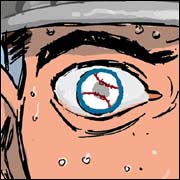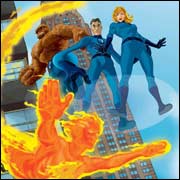Every week I go to the comic book store (Comics Ink at Overland and Braddock in Culver City, CA, hey Steve and Jason!) and grab a lot of comics. I sort these into two piles -- the "buy" pile (things I intend to spend money on, most often a small pile) and the "read" pile (often huge, including lots of stuff I don't actually like but wanna stay well informed about). In no particular order, here's some thoughts about all that.
 Wildguard #4:
Wildguard #4:
I was amazed to turn to the last page and audibly say "Oh no!" In four issues, with a huge cast of characters, I have come to care what happens in only four issues. For me, in the space of my life where I don't really care about almost anything, that's an amazing accomplishment. Nauck's simple art and straightforward story have sucked me in, and I've just barely kept myself from finding favorites (whither Jun-go?) as the whittling down must surely come. I have to say I'm coming to adore this title.
Blokhedz #1:
After illuminating news site message boards and scaring off the quick-to-judge with imagery of Tupac and Biggie (nobody noticed the Assata picture on the same panel), this issue is a conundrum. If you read it quickly, it's not that great. It's best appreciated in its nuanced corners, in throwaway images on the sides of panels. The chess metaphor, from the micro-level of people manipulated by money to the macro-level of whole communities assigned roles of chess pieces (Monarch Projects, rook imagery on another building, etc.), is sneaky and brilliant. The building of a low-income neighborhood on top of native burial grounds, given the common threads between those experiences, is interesting. The main storyline, much like the main storyline of the Matrix films, is a phantom menace, a distraction of activity that serves multiple purposes. To mix a gritty, urban experience with magical realism ... I'm watching this title, carefully.
Transformers/G.I. Joe #4:
The obscured art continues to serve the interests of this story -- when Soundwave popped up, it had impact. The action is still very tight focus, and the inability to mix large set pieces with small is starting to strain the narrative, but there's still a lot to enjoy. A real battlefield bonding moment between Roadblock and Grimlock, and a very smart moment where Scarlett and Bumblebee take on Rumble satisfies. The revelation of a really big player, part of the plans of second fiddles, makes me wonder how clear Jae Lee will get with the art, but this issue is an enjoyable is slightly forced pleasure.
Lucifer #45:
The Morningstar barely bothers to show up in a complicated tale of possession and powerlessness. The narrative tool of starting at the end is used to fine effect, but although this is not one of the strongest chapters in this title's strong run, it's a good laugh.
Captain Marvel #17:
Everything, all the way back to this current series' mad, mad inception, is up for grabs in a way that's believable and interesting while still being very, very funny. It's a family affair with chronological consequences as Genis Mar-Vell continues working towards his threat of eradicating the entire Kree, Skrull and Shi'ar races in the interests of galactic peace. But his dead mom's back, he has a sister who's got her eye on the family's birthright, and there's a whole lot unknown for a man who is supposed to know everything. The real joy of this title is that I never know what's going to be on the next page, every twist is a surprise. More fine work here.
 Human Target #5:
Human Target #5:
Dancing between fastballs and bullets, Christopher Chance is a fascinating protagonist, as his visual presentation changes so much that Milligan seamlessly makes his voice -- even in character -- crystal clear. Ignorant mess continues to happen and a body count stacks up by the end. No surprises there. I enjoy this book, and buy it because I like to support intelligent work (which this surely is), but I am sorry to say it's formed no emotional connection with me, for all its cleverness.
Daredevil #55:
I was disappointed by the finale to this David Mack-driven storyline, despite the clear artistry in the execution. Eh. I wonder what Echo will do next ...
Buy Pile Breakdown: Good stuff, with Blokhedz and Wildguard the real standouts.
Then there's the stuff on the "read pile" that I don't bring home ...
Green Arrow #33:
The goofy fun here, looking back at the silver age and rolling your eyes, was an issue I could live without. Not bad, but not good.
Brath #10:
Brath smash! It read like the commentary for the Gladiator DVD.
Red #3:
It got talky and let me down at the end (where as Kirkman's Brit basically told the same story, much more satisfyingly).
Sojourn #10:
Arwyn smash! The backstory almost came to light, like seeing Mulder and the Cigarette Smoking Man at Starbucks together, but it remained obscured. Despite the still great art, I'm losing interest.
Outsiders #7:
It's kind of like the frat house of superheroics, and overall I felt this whole issue could have been handled in four pages. The grand fight scene was nothing special, visually.
Way of the Rat #20:
More martial arts madness, this title is the spirit of "pop" comics, easily consumed and easily read.
Thundercats Origins: Villains & Heroes:
Quickie stuff that could, in theory, be inserted into toy packaging. Not worth the cash for a comic book full of 'em, though.
 Fantastic Four #508
Fantastic Four #508
Mark Waid has managed a trick I thought impossible -- he reminded me how dangerous the Fantastic Four can really be. I mean, between them there's an alarming amount and variety of power. Doom's mind is loose, and it's possessing the first family of Marvel, one at a time. Doom is considerably more severe with his use of the powers than we're used to, so there's a really good look at how crazy things can get. The crisis with the UN is settled in a way that sets up the FF for a whole new kind of lunacy, one we haven't seen them have to deal with ... maybe ever. Reed is in full mad scientist mode, showing a fascinating moment of fear and uncertainty, and this is one big, powerful issue. If (and that's a big if) Waid is able to keep turning up the volume, god help me, I may have to start buying this title.
Teen Titans #6:
Versus the JLA! Stupid superhero fights that are certain to solve nothing are, well, cliche. But at least have an interesting finish to it. This was like a printed after school special. Since when has Wonder Woman been so belligerent? Since when has Green Lantern been so rowdy? Way off on a number of bases.
Mythstalkers #6:
First, the art seems rushed and unfinished. That's a problem for me. Then, there's three small vignettes, which look like they belong to larger stories, but I'm not sure. The normal "fill you in" info I expect on the inside cover is nowhere to be seen. The issue is largely incomprehensible and highly insular. I was expecting something like the game of the same name, but I was ... bored.
Runaways #9:
Teen angst! Storming off! Super powered catfights! Not the best issue of the run, but entertaining in a Melrose Place kind of way. Yeah, I watched some of that, so what?
Robin #121:
Bill Willingham's debut with the Boy Wonder was amazingly not bad. He has deft plotting and dialogue, not as crisp as Fables but it's a wholly different monster. His introduction and handling of high school students was solid. I didn't get his fixation with putting Robin on public transportation (doesn't Robin have a car?), but it was good for some laughs and some exposition. It's still not in a groove, but it didn't suck, which is high praise for most superhero books.
Ultimate Six #5:
Intense. Five of the worst the Ultimate Universe can cook up are loose and planning all brands of hell, and they're dragging Peter Parker along for fun (with threats to his aunt and girlfriend keeping him on a short leash). Fine dialogue and plotting here (although I didn't notice that little happened until I was home), smart uses of some fairly well-known superpowers, I can't wait to see how the big showdown created on the last few pages plays out.
Shadows #4:
The art was the first thing I noticed. The detail on characters' hair, the embroidery on a girl's pants. Matt Camp can draw, y'all. The issue itself -- lots of talking heads and some yelling of an administrative and personality-clash nature -- managed to keep my interest in part due to the art. Given one bit with a phone and some liquor bottles, I'd guess Camp uses tons of photo reference, but I don't care -- it's fine work. The book could do with an opening page "what the hell?" kind of intro, but the grayscaling suits the somber tone quite well, and I can see why people who already know what's going on love this book. I'm somewhat interested ...
Read Pile Roundup: Not really a chore getting through it all, and a real pleasure reading FF and Way of the Rat.
With four clear good memories of this week and a score of "aight" reads, we'll call it a good one overall.


 Wildguard #4:
Wildguard #4: Human Target #5:
Human Target #5: Fantastic Four #508
Fantastic Four #508